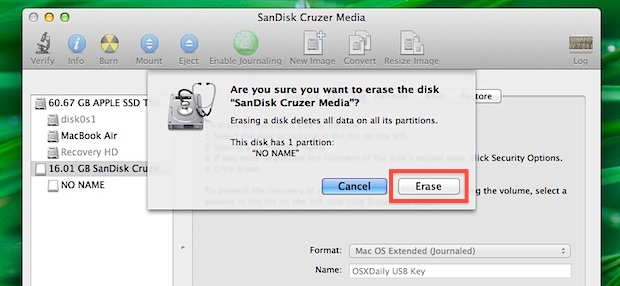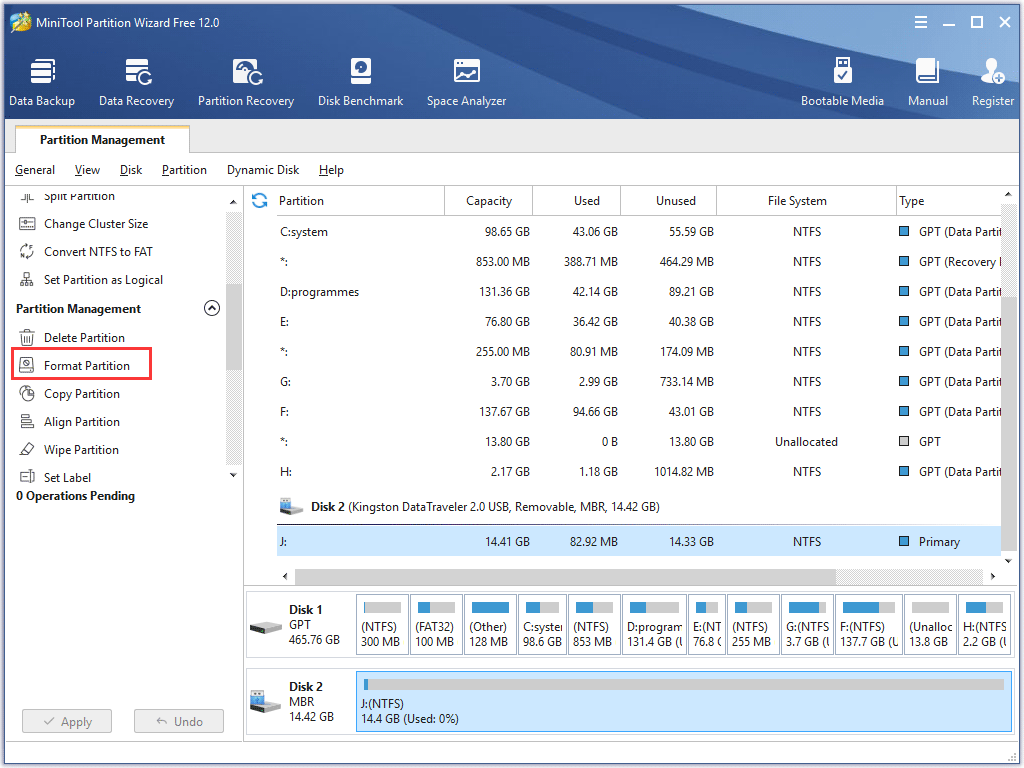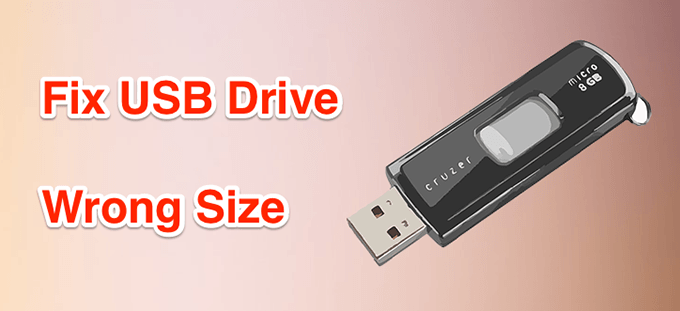While APFS is optimized for the Flash/SSD storage used in recent Mac computers, it can also be used with older systems with traditional hard disk drives (HDD) and external, direct-attached storage. MacOS 10.13 or later supports APFS for both bootable and data volumes. APFS allocates disk space within a container (partition) on demand.
Mac OS Extended (Journaled) This format is considered as default file system format of the Mac OS X drives. It also supports OS X Lion, like Versions. This format will allow you to use your flash drive on Mac without any limitations. Best 5 USB flash drive formatting software for Mac. USB flash drive formatting software for Mac can help us format, reformat or erase USB flash drive on Mac. Here are top 5 USB flash drive formatting software for Mac on the market to help us securely & efficiently format USB flash drive under Mac OS.
Disk Utility User Guide
Disk Utility on Mac supports several file system formats:
Apple File System (APFS): The file system used by macOS 10.13 or later.
Mac OS Extended: The file system used by macOS 10.12 or earlier.
MS-DOS (FAT) and ExFAT: File systems that are compatible with Windows.
Apple File System (APFS)
Apple File System (APFS), the default file system for Mac computers using macOS 10.13 or later, features strong encryption, space sharing, snapshots, fast directory sizing, and improved file system fundamentals. While APFS is optimized for the Flash/SSD storage used in recent Mac computers, it can also be used with older systems with traditional hard disk drives (HDD) and external, direct-attached storage. macOS 10.13 or later supports APFS for both bootable and data volumes.
APFS allocates disk space within a container (partition) on demand. When a single APFS container has multiple volumes, the container’s free space is shared and is automatically allocated to any of the individual volumes as needed. If desired, you can specify reserve and quota sizes for each volume. Each volume uses only part of the overall container, so the available space is the total size of the container, minus the size of all the volumes in the container.
Choose one of the following APFS formats for Mac computers using macOS 10.13 or later.
APFS: Uses the APFS format. Choose this option if you don’t need an encrypted or case-sensitive format.
APFS (Encrypted): Uses the APFS format and encrypts the volume.
APFS (Case-sensitive): Uses the APFS format and is case-sensitive to file and folder names. For example, folders named “Homework” and “HOMEWORK” are two different folders.
APFS (Case-sensitive, Encrypted): Uses the APFS format, is case-sensitive to file and folder names, and encrypts the volume. For example, folders named “Homework” and “HOMEWORK” are two different folders.
You can easily add or delete volumes in APFS containers. Each volume within an APFS container can have its own APFS format—APFS, APFS (Encrypted), APFS (Case-sensitive), or APFS (Case-sensitive, Encrypted).
Mac OS Extended
Choose one of the following Mac OS Extended file system formats for compatibility with Mac computers using macOS 10.12 or earlier.
Mac OS Extended (Journaled): Uses the Mac format (Journaled HFS Plus) to protect the integrity of the hierarchical file system. Choose this option if you don’t need an encrypted or case-sensitive format.
Mac OS Extended (Journaled, Encrypted): Uses the Mac format, requires a password, and encrypts the partition.
Mac OS Extended (Case-sensitive, Journaled): Uses the Mac format and is case-sensitive to folder names. For example, folders named “Homework” and “HOMEWORK” are two different folders.
Mac OS Extended (Case-sensitive, Journaled, Encrypted): Uses the Mac format, is case-sensitive to folder names, requires a password, and encrypts the partition.
Windows-compatible formats
Choose one of the following Windows-compatible file system formats if you are formatting a disk to use with Windows.
MS-DOS (FAT): Use for Windows volumes that are 32 GB or less.
ExFAT: Use for Windows volumes that are over 32 GB.

Not every USB drive can be used on Mac out of the box -- you need to format the drive to make sure it's compatible with the MacOS extended file system. And here in this article, we'll offer you a full guide on how to format a USB Drive on Mac. Besides, in case you lose important data due to formatting, we have a professional data recovery tool to help you recover data from a formatted USB drive on Mac.
Bonus: How to Recover Lost Data After Formatting USB Drive
Part 1. What You Should Do First Before Formatting USB Drive on Mac
Make sure that уоu know clearly whаt уоu are doing whеn you begin the whole formatting process, which will еrаѕе your еntirе hаrd drivе.
To avoid formatting the wrong disk, firstly remove the USB drive from Mac, check the title of other storage disks, then insert the USB disk again and note the name of the disk. Next, drag the USB data to a safe location for backup/recovery measures before formatting it. Then you are set to get it done!
Part 2. What Is the Best Format for USB Drive on Mac?
You'll be given several format options when you try to format a USB drive on Mac, including Mac OS X Extended (Journaled), Mac OS X Extended (Case-sensitive, Journaled), Mac OS X Extended (Journaled, Encrypted), Mac OS X Extended (Case-sensitive, Journaled, Encrypted), MS-DOS (FAT) and ExFAT. If you are using macOS 10.13 or later, you'll also see an option named APFS, which is the default file system of macOS 10.13 and later.
1APFS (Apple File System)
APFS is a new file system for macOS. It's the most appropriate format for SSD. However, you need the latest macOS to write to this file system. If you're sure that you don't need to use it on a Mac running old version in the future, then you can format your USB drive to APFS.
2Mac OS X Extended (Journaled) & Mac OS X Extended (Case-sensitive, Journaled)
Mac OS X Extended, aka HFS+, is the default file system before APFS for macOS 10.12 and earlier. It doesn't put a limit on the size of files you can save on the drive, which is the greatest advantage. Windows-running computers can read the files formatted to Mac OS X Extended but can't write to them. And this file system is necessary if you plan on using the drive for Time Machine backups.
The biggest difference between Mac OS X Extended (Journaled) and Mac OS X Extended (Case-sensitive, Journaled) is the latter one is case-sensitive to folder names. For example, 'file' is different from 'File'. Therefore, if you do not have special needs, just ignore this option.
3Mac OS X Extended (Journaled, Encrypted) & Mac OS X Extended (Case-sensitive, Journaled, Encrypted)
These two are basically the same with the previous two but with encryption, which means you have to provide the password whenever you connect the drive to your Mac.
4MS-DOS (FAT)
This is Disk Utility's name for FAT32 file system. As the most widely compatible file system, it suits both Windows operating system and macOS. Therefore one can easily transfer data between PC and Mac using a USB drive formatted this way. However, a USB drive formatted to FAT32 doesn't support long file names and an individual file cannot be larger than 4GB.
5ExFAT
ExFAT is the improved version of the older FAT32, which offers larger storage space and supports files larger than 4GB. Of course it also supports transferring files between PC and Mac as a cross-platform file system.
To arrive at a conclusion, if you need to transfer smaller files between operating systems, choose MS-DOS (FAT) or FAT32. And with no doubt, ExFAT will be the best format for USB drive on Mac for larger files.
Part 3. How to Format USB to FAT32/ExFAT on Mac
As earlier stated, you need to first back up your USB drive before formatting it as the formatting operation will wipe all the data. Now, you can follow the steps highlighted below to get the USB successfully formatted.
Method 1: Format a USB Drive on Mac OS with Disk Utility
Step 1: Insert the USB waiting to be formatted to a Mac computer.
Step 2: Navigate to Applications > Utilities, and click it twice to open it.
Step 3: Select the drive you want to format and click on Erase.
Step 4: Rename the USB drive (optional), and choose one file system from the options.
Step 5: Then select Master Boot Record for scheme, hit Erase.
Step 6: Once the process is done, you are ready to use the drive with new file system to store data again.
Method 2: Convert/Format USB Drive to FAT32/ExFAT
Step 1: Connect the USB drive to your Mac computer.
Step 2: Click on cmd + space to run Spotlight, input terminal then tap Enter key.

Step 3: Type diskutil list to find the location of your USB drive (eg: dev/disk2 is the USB drive in the below picture).
Step 4: Type sudo diskutil eraseDisk FAT32 MBRFormat /dev/disk2.
sudo gives you user right.
Diskutil calls disk utility program.
eraseDisk commands the formatting.
FAT32 sets the file system.
MBRFormat tells disk utility to format with a Master Boot Record.
/dev/disk2 is the location of the USB drive.
Note: You can replace FAT32 with ExFAT in the command, and your USB drive will be formatted in that way.
After the process completes, type diskutil list in command once more to check if the USB drive has been formatted successfully.
Bonus: How to Recover Lost Data After Formatting USB Drive
Best Flash Drives For Macs
Formatting a USB drive is never an easy task and problems tend to arise from time to time, among which data loss is perhaps the most common one. Users format a USB drive by mistake or directly format it without doing any backup job and both mistakes will cause data loss disaster. This issue will worry us even more when there are important files we cannot offord to lose. If this is the case, you'll need a professional data recovery software to help you get back lost files, and AnyRecover is what you need exactly. With this software, anyone can recover all kinds of data from formatted USB drive on Mac with only 3 simple steps.
As a comprehensive Mac data recovery solution, it handles all data loss scenarios, including formatting USB drive, hard drive failure, and Mac crash.
All-round and deep scan ensures high recovery rate, and sophisticated algorithms contribute to quick scanning speed.
Supports data recovery on all types of USB drives in various file formats like NTFS, HFS+, FAT32, and ExFAT.
Brings back the lost photos, videos, documents, compressed files, etc. - numerous kinds of data from formatted USB drive easily.
Provides preview before recovery and enables selective recovery.
NoteAnyRecover offers free trial for every user, with which one can scan, preview and recover 3 files for free. Just download and have a try! The more time for hesitation, the less possibility for your lost data to get back!
Follow the simple steps below to recover data after formatting USB drive on mac:
Step 1: Make sure you have connected your USB drive to your Mac successfully. Download, install and launch AnyRecover. Then select the formatted USB drive you are trying to recover data from as the location to find data. Press the 'Start' button to initiate the scanning.
Step 2: The software will immediately begin the scanning process. You can pause the process at any time and resume from that point later.
Step 3: Immediately after the scanning process is complete, all the files will be listed in their respective file formats and folders. Freely preview and choose what to recover by clicking on 'Recover' button.
Final Words

Best Format For Usb Flash Drive Mac And Pc
Formatting is a complicated process indeed but by clearing your mind and then follow the steps as listed out in the article, you can successfully format a USB drive on Mac without much difficulty or errors. Loss of data may come as a nightmare but AnyRecover is powerful enough to help you out. In fact, not just after you format a USB drive, it can work wonders whenever you lose data. Try it and you won't be disappointed.